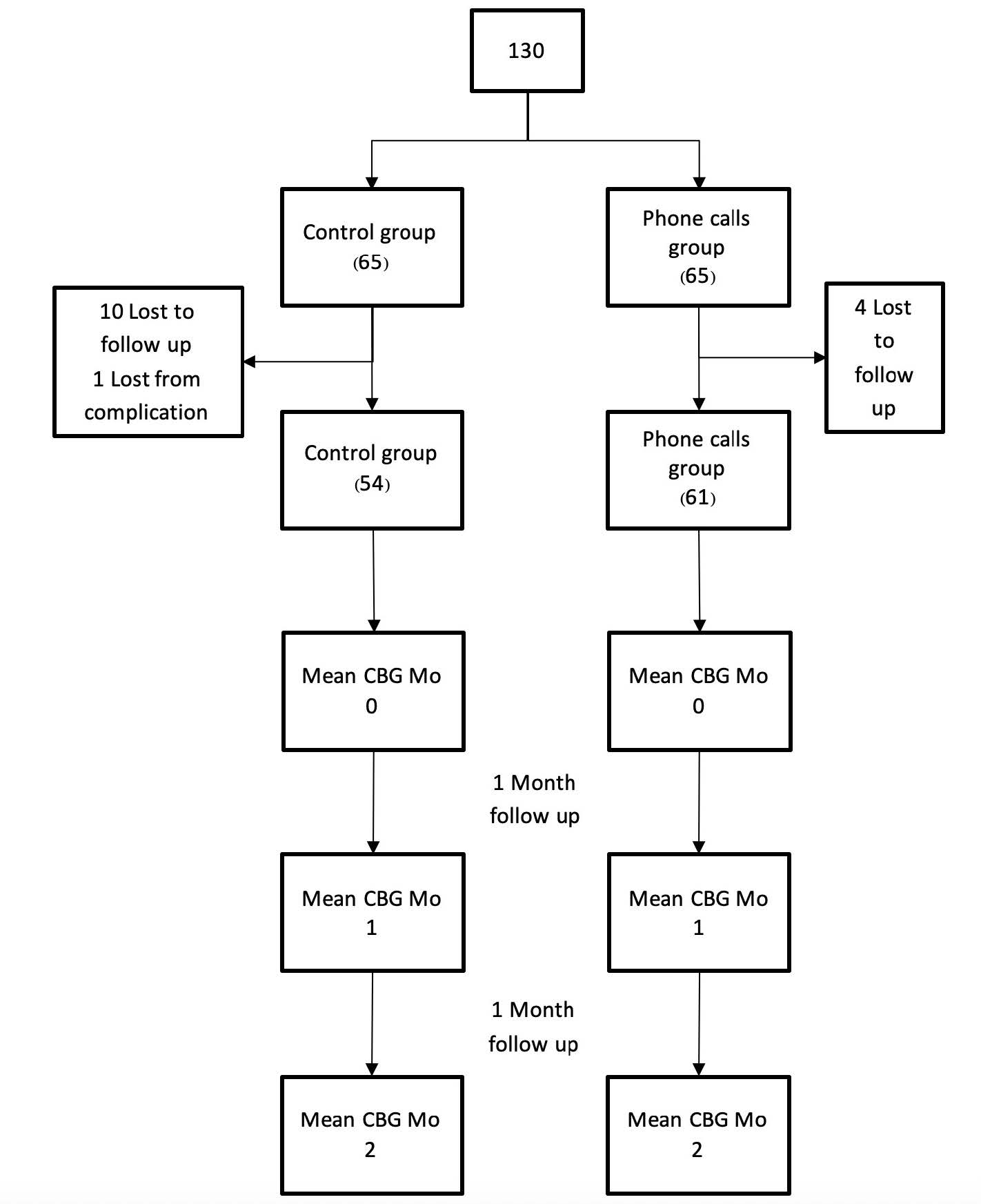The Efficacy of Follow-up Phone Calls for Capillary Blood Glucose Lowering in Diabetic Patients in Primary Care Unit
DOI:
https://doi.org/10.33192/Smj.2021.104Keywords:
Diabetes mellitus type 2, Phone call, Glycemic controlAbstract
Objective: To study the effect of telephone call intervention on glycemic control in diabetic patients for 2 months
Materials and Methods: The quasi-experimental research included 130 Patients from January 2020 to March 2020 in primary care. The 115 patients were divided into 2 groups through a simple randomization process, 61 in experimental group and 54 in control group after exclusion. 115 Patients will be tested for Capillary blood glucose (CBG) level at a period of 0-month, 1-month and 2-months. CBG level were presented in mean ± SD, mean difference ± SD and analyzed by Independent t-test and Paired t-test.
Results: The phone call intervention can lower CBG level compared to the control group. Mean difference of CBG between 0 month and 2 months follow-up in phone calls group vs control group (-6.80 ± 4.86 vs -2.96 ± 4.82 mg/dL) and mean difference CBG level between 1 month and 2 months follow-up in phone calls group vs control group (-5.77 ± 4.09 vs -4.22 ± 5.10 mg/dL) but had no significant difference (p >0.05)
Conclusion: The follow-up phone calls can lower CBG level in the experimental group more than the control group, but there is no significant difference.
References
Mahidol University. Situation of Thai Elderly 2017 (1st Edition). Nakornpathom: Printory Company, 2018.
2. Diabetic Association of Thailand under the Patronage of Her Royal Highest Princess Maha Chakkri Siridhron. Clinical
Practice Guideline for Diabetes 2017. Bangkok: Romyen Media Company; 2016.
3. International Diabetes Federation. IDF DIABETES ATLAS Ninth edition 2019[Internet]. 2019 [cited 10 January 2020].
Available from: https://www.diabetesatlas.org/upload/resources/ 2019/IDF_Atlas_9th_Edition_2019.pdf
4. Hdcservice.moph.go.th [Internet]. Thailand: The percentage of blood sugar control among diabetic patients in 2019 [update
November 17,2019].Available from: https://hdcservice.moph. go.th/hdc/reports/report.php?source=pformated/format1.
php&cat_id=b2b59e64c4e6c92d4b1ec16a599d882b&id=137a726340e4dfde7bbbc5d8aeee3ac3
5. The Office of the National Economic and Social Development Boar, MOPH, Thailand. Thailand Healthy Lifestyle Strategic
Plan 2011-2020 [Internet].2553[cited 13 January 2020].Available from: http://wops.moph.go.th/ops/oic/data/20110316100703_1_.
6. Suksomboon N, Poolsup N, Nge YL. Impact of Phone Call Intervention on Glycemic Control in Diabetes Patients: A
Systematic Review and Meta-Analysis of Randomized, Controlled Trials. PLoS ONE 2014;9(2):e89207.
7. Jerawatana R, Reutrakul S, Siripitayakunkit A. The Effect of Advanced Practice Nurse-Led Intervention Program on
Outcomes in Diabetes Patients with Complex Problems. Rama Nurs J 2018;24(1):51-68.
8. Bogner HR, Morales KH, de Vries HF, Cappola AR. Integrated management of type2 diabetes mellitus and depression treatment
to improve medication adherence: a randomized controlled trial. Ann Fam Med 2012;10:15–22.
9. Dale J, Caramlau I, Sturt J, Friede T, Walker R. Telephone peer delivered intervention for diabetes motivation and support:
the telecare exploratory RCT. Patient Educ Couns 2009;75:91–98.
10. Walker EA, Shmukler C, Ullman R, Blanco E, Scollan-Koliopoulus M, et al. Results of a successful telephonic intervention to improve diabetes control in urban adults: a randomized trial. Diabetes Care 2011;34:2–7.
11. Theeraakarawipas N. Effectiveness of a Model of Care for Diabetis Mellitus Patient Who Could not Control Blood Sugar. J Health Science 2019;28:466-77.
12. American Diabetes Association. 2. Classification and diagnosis of diabetes: Standards of Medical Care in Diabetes 2020. Diabetes Care 2020;43(Suppl 1):S14–S31.
13. Thomas R. Freeman. McWhinney’s Textbook of Family Medicine. 4th Edition. NY: United States of America by Oxford University Press; 2016

Published
How to Cite
Issue
Section
License
Authors who publish with this journal agree to the following conditions:
Copyright Transfer
In submitting a manuscript, the authors acknowledge that the work will become the copyrighted property of Siriraj Medical Journal upon publication.
License
Articles are licensed under a Creative Commons Attribution-NonCommercial-NoDerivatives 4.0 International License (CC BY-NC-ND 4.0). This license allows for the sharing of the work for non-commercial purposes with proper attribution to the authors and the journal. However, it does not permit modifications or the creation of derivative works.
Sharing and Access
Authors are encouraged to share their article on their personal or institutional websites and through other non-commercial platforms. Doing so can increase readership and citations.














